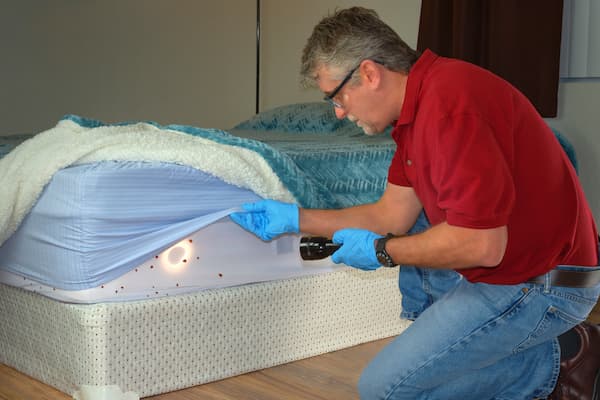Discovering the Scientific Research Behind Bed Bug Warm Treatments as a Sustainable Bug Management Approach
In the realm of pest administration, the pursuit for efficient and lasting services continues to be a constant search. One such technique that has actually obtained traction in current years is making use of warmth treatments to combat bed insect problems. By utilizing the scientific research behind thermal death points for these relentless pests, warm therapies offer an appealing choice to traditional chemical-based methods. The details of how heat efficiently removes bed pests and the broader effects for lasting pest management methods make this a subject worth discovering better.
Bed Insect Warm Treatment Process

Thermal Fatality Point for Bed Insects
Revealing bed insects to elevated temperatures past their thermal tolerance array is crucial for attaining effective elimination in warmth therapy procedures. The thermal fatality point for bed insects describes the temperature at which these parasites can not make it through. Study suggests that bed insects begin to perish when revealed to temperatures above 113 ° F(45 ° C) for a sustained duration. As the temperature enhances, so does the death rate of bed insects. At around 118 ° F(48 ° C ), bed insects start to die quickly, with a mortality price of nearly 99% within minutes of direct exposure. This shows the sensitivity of bed insects to high temperature levels and highlights the effectiveness of warmth treatments in removing problems. By reaching and preserving temperature levels over the thermal death point for bed insects, bug monitoring specialists can guarantee detailed removal of bed pest populations, including hard-to-reach areas where chemical treatments might be much less reliable. Understanding the thermal death point for bed bugs is vital for applying effective warmth therapy strategies and achieving sustainable insect administration results.
Advantages of Heat Treatments
Having developed the important thermal death point for bed pests, it is essential to now discover the considerable advantages that warmth therapies provide in effectively getting rid of these durable insects. Heat therapies present numerous crucial benefits when contrasted to conventional chemical methods. Among the primary benefits is that heat can pass through deep into holes and fractures where bed pests hide, ensuring that also the most hard-to-reach areas are heated to deadly temperatures. This thorough technique not only eliminates online bugs yet likewise targets bed bug eggs, protecting against future invasions.
In addition, heat treatments are non-toxic and eco-friendly, making them a lasting parasite monitoring strategy. Unlike chemical pesticides, heat treatments do not leave harmful residues that can position threats to human health or the atmosphere. This element is specifically vital in delicate environments such as medical facilities, institutions, and suburbs where chemical use may not be desirable.
Additionally, heat treatments have a high success rate in eliminating bed insect invasions in a single treatment, lowering the need for multiple gos to and minimizing disruption to occupants. This efficiency not just conserves time and cash but also provides satisfaction to those managing bed pest issues.
Effectiveness of Heat Therapy

Research research studies have continually demonstrated the performance of warm therapies in accomplishing a high price of bed insect death. Properly carried out heat therapies can get to all the cracks and gaps where bed bugs may be nurturing, making sure a comprehensive approach to extermination. Heat therapies have actually the included advantage of killing bed insect eggs, which are often immune to conventional chemical therapies. On the whole, the performance of heat treatments in removing bed pest infestations makes them a lasting and trusted bug monitoring technique.
Sustainable Insect Management Benefits
Applying lasting bug administration practices offers long-term advantages for both the environment and public health. By using approaches such as warm therapies for bug control, we can lower the reliance on dangerous chemical pesticides that can have negative impacts on ecosystems and human health and wellness - DC exterminator. Sustainable parasite administration next techniques aid in protecting biodiversity by targeting particular pests without damaging non-target organisms, thus maintaining a balanced ecological community
Moreover, sustainable bug management practices add to the overall wellness and well-being of the general public. By minimizing direct exposure to toxic chemicals made use of in traditional pest control techniques, heat therapies offer a more secure option for parasite management in household, commercial, and public spaces. This decrease in chemical usage additionally helps in stopping chemical deposits from polluting water, dirt, and air, securing ecological high my link quality.
Conclusion
To conclude, bed pest heat treatments have actually been revealed to be a sustainable and efficient parasite management technique. The thermal death factor for bed pests makes them susceptible to heat treatments, which have many benefits over traditional chemical treatments. The effectiveness of warm therapies in removing bed pest problems while minimizing environmental effect highlights the capacity of this technique as a lasting option for parasite control.
The bed pest warmth therapy procedure involves raising the temperature within infested areas to a level that effectively eliminates bed bugs and their eggs. By reaching and maintaining temperatures over the thermal fatality factor for bed insects, pest management professionals can ensure extensive elimination of bed bug populaces, consisting of hard-to-reach locations where chemical therapies may be less effective. One of the primary benefits is that warmth can pass through deep right into splits and gaps where bed bugs conceal, making certain that also the most hard-to-reach locations are heated to lethal temperature levels. Unlike chemical therapies that may leave behind resistant populaces, warmth treatments provide a non-toxic and eco pleasant option that can penetrate deep right into furnishings, walls, and various other hard-to-reach locations where bed bugs conceal.
The thermal fatality point for bed pests makes them prone to heat therapies, which have important link many advantages over traditional chemical therapies.